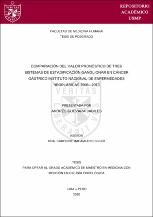Comparación del valor pronóstico de tres sistemas de estadificación ganglionar en cáncer gástrico Instituto Nacional de Enfermedades Neoplásicas 2008 - 2013

View/
Trabajo
(application/pdf: 1.006Mb)
(application/pdf: 1.006Mb)
Date
2020Author(s)
Guevara Jabiles, Andrés
Advisor(s)
Malamud Kessler, Caroline
Metadata
Show full item recordAbstract
The log odd of positive lymph nodes (LODDS) and the lymph node ratio (LNR) are alternative lymph node (LN) staging systems in cancer staging. Objective: Compare which of the lymph node staging systems has the best predictive value for overall survival in patients with resectable gastric cancer who underwent surgery. Methods: 673 medical records of gastric cancer patients who underwent radical gastrectomy with D2 lymphadenectomy between 2008 and 2013 were retrospectively review in the National Cancer Institute from Peru. The discriminatory ability and prognostic stratification were analyzed with log likelihood, Akaike information criterion (AIC) and the area under the curve (AUC) of the receiver operating characteristic (ROC) curve. Results: 667 (99.1%) patients had more than 15 LN retrieved, 451 (67%) were node-positive and 42 (range 8-153) as median lymph nodes analyzed. The five-year overall survival was 57%. pN, LNR and LODDS resulted as independent prognostic factors for survival in multivariate analysis in each model (p0.001). LODDS showed greater discriminatory ability in all the different subgroups of lymph nodes. There was significant differences in the overall survival among patients with no-lymph node metastasis (pN0 and LNR0), pN2 and pN3a after stratified in LODDS system (p0.05). The predictive value of the pN improved as the number of retrieved lymph node increased. Conclusion: LODDS appears to be the most powerful LN staging system for patients with resectable gastric cancer following radical gastrectomy with D2 lymphadenectomy with high median of lymph nodes harvested.
Collections
- Tesis de maestría [562]
Publisher
Universidad de San Martín de Porres
Type of research
https://purl.org/pe-repo/renati/type#tesis
Rights
info:eu-repo/semantics/openAccess
Notes
Resumen:
El logaritmo de probabilidades de ganglios positivos (LODDS) y la proporción de ganglios metastásicos (LNR) son sistemas de estadificación ganglionar alternativos. Objetivo: Comparar cuál de los sistemas de estadificación ganglionar presenta mayor valor pronóstico en sobrevida global en pacientes con cáncer gástrico resecables y operados. Metodología: 673 pacientes que tuvieron gastrectomía radical con linfadenectomía D2 en el Instituto Nacional de Enfermedades Neoplásicas (INEN) entre los años 2008 y 2013 fueron incluidos. La habilidad discriminatoria y valor pronóstico de cada sistema fue analizada con la prueba de log likelihood, Akaike information criterion (AIC) y la curva del receiver operating characteristic (ROC) y el área bajo la curva (AUC). Resultados: La mediana de ganglios resecados fue de 42 (rango 8-153), 451 (67%) tuvieron pN (+) y 667 (99.1%) pacientes presentaron más de 15 ganglios resecados. La sobrevida global a los cinco años fue 57%. El pN, el LNR y el LODDS fueron factores independientes para cada modelo (p0.001) en el análisis multivariado. El sistema LODDS mostró superioridad, así como en los subgrupos según el número de ganglios resecados. Los pacientes clasificados como pN0, pN2, pN3a y LNR0 tuvieron re categorización significativa bajo el sistema LODDS (p0.05). El valor predictivo del pN mejora a medida que aumenta el número de ganglios resecados. Conclusión: El sistema LODDS presenta mayor habilidad discriminatoria en los pacientes con cáncer gástrico operados de gastrectomía radical con linfadenectomía D2 con promedio alto de ganglios resecados.







